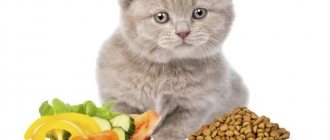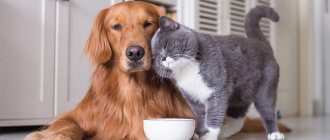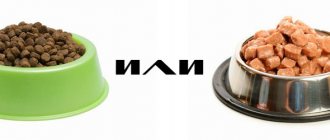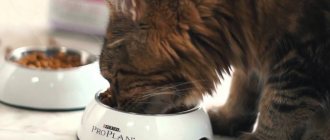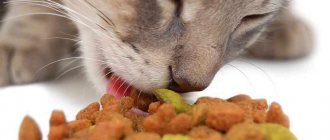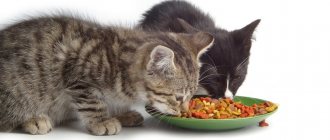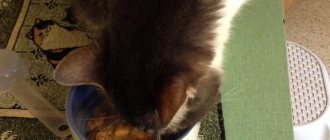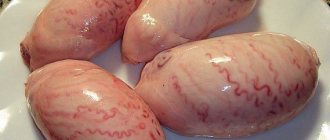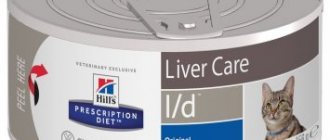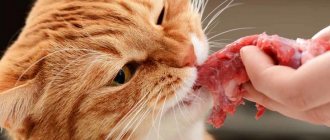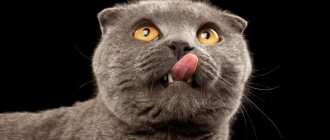Any owner who decides to have an animal in the house immediately asks the question: what to feed it? Everyone is looking for answers to it in their own way, trying out different methods and various combinations, but a significant indicator that the diet is balanced is the excellent health and activity of the furry pet.
For those owners who decide to stick to an industrially produced cat menu, veterinarians advise using both dry and wet high-quality food from the same manufacturer and brand. But it often happens that a cat completely refuses to eat crackers, demanding only pates or pouches for lunch. But is it possible to feed a cat only wet food, that’s the dilemma.
How to choose the right wet food
Not all wet food packages are labeled as complete food. If there is no such mark, it means that the product was not balanced with all the necessary nutrients, which can also be noticed by the absence of a vitamin-mineral premix in the composition.
Most often, such products consist of one type of meat or fish, as well as a mixture of them in different proportions. This does not mean that the product is bad, it just cannot be fed to it constantly, but only treated to the cat periodically, in addition to the main diet.
Does moist mean it's healthier?
Many owners believe that wet food is healthier than dry food or vice versa, but this is not true - each of these types of food has its own disadvantages and advantages. With complete wet foods, the latter are quite obvious.
On the one hand, cats certainly like such foods more; in addition, they contain a lot of moisture, and consuming enough liquid is critically important for cats. There is another positive point: such food does not require the addition of preservatives, because in sealed packaging the product does not spoil for a very long time.
True, this is a conditional advantage; high-quality dry food uses tocopherol-based preservatives, which do not have any harmful effects on the cat’s body. But there are still exceptions!
Well, the main disadvantage of wet food is the price; feeding them only will cost the owner much more.
General information
The popularity of industrial cat food is understandable - owners have no time to prepare food for their pets. Ready-made food can be placed in a bowl and stored for a long time - this is undoubtedly convenient. Striving for convenience, do not forget about the needs of the cat, because its health depends on a balanced diet!
You should not feed your pet with economy class food . These products are made from cereals and do not contain meat or vitamins. Simply put, cheap food is a useless filler for the stomach. In addition, economy class products contain salts and preservatives, which contribute to the development of urolithiasis.
Premium and super-premium classes are considered optimal for everyday feeding. However, you should not blindly trust the inscriptions on the packs! Read the composition of the product, only it will show the true value of the food. Some manufacturers believe that food containing 70% grains is healthy, but this is far from true. Holistic class foods are considered the most natural, but they also have the highest price.
Feed your cat the usual wet food and little by little
When feeding wet diets, you should avoid variety; it is better to choose one type of food that suits your cat and stick with it. Constantly changing your pet’s diet is neither necessary nor beneficial.
Unlike dry food, wet food cannot be left in a bowl, so the feeding pattern will be fundamentally different. The daily intake should be determined according to the instructions on the product packaging and adjusted depending on the condition of the animal. To prevent overeating, get into the habit of weighing your cat regularly.
The daily norm should be divided into several feedings and given often, but little by little. We immediately put the uneaten portion in the refrigerator, and then be sure to warm it up to room temperature in the microwave.
The contents of an open package can be stored in the refrigerator for no more than a day in a tightly closed container, for which the edges of the bag are tightly wrapped and secured with a paper clip, and the contents of the jar are transferred to a glass or plastic container with a lid. It is very important to wash the bowl after each feeding because even microscopic remains of wet food become a breeding ground for bacteria.
If you do not have the opportunity or time to feed your cat wet food correctly, taking into account all of the above, it is better to abandon this idea in favor of high-quality dry food.
And one more thing: despite the fact that canned diets contain a lot of moisture, feeding wet food does not negate strict control over the cat’s water intake.
Why doesn't my cat want to eat dry food?
Many people say that we gave you this dry food, the cat doesn’t want to eat it, but eats wet food.
It’s just that the absolute majority of wet food adherents gave their cat the same dry Whiskas, Kitekets, etc. to try. Therefore, it is not surprising that the cat did not eat them. For a cat to be offered Royal Canin, Tim Breeder, Pro Plan and Leonardo, for example, and for it to refuse all this is completely unbelievable.
Those who really love their cat will spend time choosing high-quality food for her, which she will eat with pleasure. And whoever says that he loves them will give a couple of the first ones he comes across to try, and will return to the humid Kitekets, like, his conscience is clear.
Such owners also like to say that since the cat did not eat, it means that there is some kind of rubbish in this dry food. And if the wet food is eaten with pleasure, then everything is fine with it. You can’t fool the beast, that’s how we check the sausage: if the cat doesn’t eat it, it means the sausage is bad. Such reasoning is primitive. They are due to ignorance of what cats focus on in food. And they focus primarily on smell. Therefore, you just need to add flavoring to bad sausage, and the cat will eat it like crazy. It’s the same with bad food - they put in an aromatic additive, and the cat eats it. And the naive owner will not be overjoyed. Before your first visit to the vet, of course...
Is it possible to combine canned food with other types of food?
It is possible if you follow feeding standards. When canned food and dry food are produced by the same manufacturer, you can find the appropriate instructions on the packaging. For example, in the table opposite the cat’s weight it may be written like this: 30 g of dry food + 1 ½ bags of wet food. This is the daily norm for a mixed diet.
If the manufacturers are different, then you need to experiment yourself. As a starting point, take half the daily intake of dry food and half of wet food (in accordance with the general recommendations on the package). Then monitor the animal’s condition and adjust the norm if it loses or, conversely, gains weight.
The biggest mistake that owners make when buying wet food for their cats is that they don’t consider it food, but tend to classify it as something like a dessert that they can treat their cat to. Nevertheless, this is food, and it must fit into the cat’s daily diet. Otherwise, overeating cannot be avoided, and with it all the accompanying problems.
Types of industrial rations
The modern market for animal products offers several types of wet production diets. They differ in their composition and price:
- Holistics are the most expensive product, characterized by excellent quality. The composition contains exclusively natural products, the source of protein is meat. The products contain vitamins and minerals that satisfy the daily needs of a growing body. The disadvantage is the high price, not sold in all stores.
- Super-premium - they are cheaper than holistic ones, but they also have a natural and balanced composition, including useful components.
- Premium is a high-quality food enriched with vitamins and minerals, containing, in addition to meat and vegetables, seaweed and fruits.
- Economy - a budget option. Low cost results in appropriate quality. The composition may contain preservatives, thickeners, flavor enhancers, flavorings, and chemical additives, which often cause indigestion and allergic reactions in kittens.
Owners of kittens are advised to immediately make a choice, taking into account their financial capabilities. Subsequently switching from expensive to cheap brands with preservatives in their composition can negatively affect the health of the animal.
When does a kitten become a cat?
Kittens are young, playful and still learning to play. During this time, they are very active for some time, but they also need to sleep for long periods of time. They will use their brains to learn new behaviors and learn new skills.
© shutterstock
Young kittens also form new relationships with their humans and other animals. When a kitten reaches about 6 months of age, it is considered an adolescent, so a kitten between 6 and 12 months of age is more like a teenage child. They will begin to develop most of their skills, they should have a good understanding of what is right and wrong, but they will still have a lot of pent up energy to burn off.
Once a kitten reaches 12 months of age, it is considered an adult cat, although giant breeds may not be fully developed until 18 months of age. For a normal-sized indoor cat, you will want to switch from kitten food to adult cat food at 12 months.
Analysis of the composition
For comparison, let’s take the actively advertised and well-known Whiskas food and one of the best holistic food according to the 2018 rating - Applawls.
- The first ingredients are in the composition. The first place in the composition is always occupied by the product whose content percentage is the highest. For Whiskas this is meat and offal (leftovers that cannot be used for humans). The total content of all this in the feed is not known; what by-products are used is not indicated. The only information on the packaging is that the meat content of lamb and beef must be at least 4%.
In Applawls food, tuna fillet comes first (from 50% to 75%, depending on the selected food).
- Plant components. Whiskas ranks second with cereals, the qualitative and quantitative composition of which is not specified. In Applawls, cereals are found in small quantities, it is indicated that this is rice.
- Mineral supplements, vitamins. Both Whiskas and Aplauls contain brewer's yeast (B vitamins) and taurine. The second food also includes berries and herbs - the secret of your pet’s genitourinary health.
- The nutritional value. Whiskas food states that it contains 8.5% protein, but due to incomplete information on the packaging, we cannot say that all the protein is of animal origin. Applawls food contains 13.5% protein. Both foods contain the same amount of moisture – 82%. At the same time, Whiskas food is ten times fatter than Applawls - the first contains 5% fat, and the second 0.5%.
We compared the compositions of the most famous economy food and the best holistic food. Since a cat is a carnivorous animal, its diet should include meat. Also, we must not forget about such necessary components as: vitamins, amino acids, berries and herbs. In addition, the food must be balanced in terms of protein, fat, moisture and carbohydrates.
In all these characteristics, Applawls food will be significantly ahead of Whiskas. Plus, it uses high-quality and expensive raw materials. Also, all food above the premium class contains medicinal lines of food, food for kittens, sterilized cats , or cats with digestive problems. Thanks to this, you can always choose the food that is ideal for your cat.
If you buy liquid food for your pet, then undoubtedly it should be super-premium, or at least premium. Representatives of the economy line can only be used once, if there are no other options.
What not to do with mixed feeding
As you already understand, mixed feeding is not just adding wet food to dry food or vice versa. It involves creating a balanced diet, in which both products serve as an organic and complete element.
If you have carefully selected wet food and dry food, and believe me, this is not an easy task with all the variety of choices, then you should not change brands and indulge in unnecessary experiments. Of course, sometimes you want to pamper your cat with something tasty, but it’s better to buy him a treat than to grab the first bag he likes and replace such a carefully selected product with it, disrupting your pet’s diet. This won't lead to anything good.
Why is mixed feeding usually used?
Most often, the choice of this type of food is based solely on the desire of the owner. Many people believe that a cat, deprived of fragrant pieces from a jar or bag, feels disadvantaged. In fact, this is not entirely true. A cat feels happy if he is fed and healthy. Both the first and second are achieved with the help of a well-chosen diet.
Of course, there are circumstances when the introduction of wet food is required due to the condition of the animal, for example, in order to increase the amount of water in the diet, in case of undergoing surgery or loss of appetite.
If dry food is chosen correctly, contains a large amount of meat and fully provides the pet’s body with all the necessary substances, and the cat is healthy and looks good, there are no physiological prerequisites for introducing wet food into the diet.
However, there are no special contraindications to combining dry and wet food, provided that they are equivalent in nutritional content and meet the needs of carnivores. If you are already feeding Acana or Orijen food, then you need to be especially careful when choosing canned food that will be combined with them.
When do you need to change the type or diet of feeding?
When the food suits your pet and does not cause allergies, there is no need to change it. It happens that a cat refuses to eat for a day or two, this is normal if there are no signs of illness: vomiting, fever, diarrhea. This is how the animal cleans itself.
During this period, you can offer him a different diet option; perhaps pate or pieces in jelly instead of the usual dry food will stimulate his appetite. You can change the type of food during the rehabilitation period after an illness, when a cat is feeding kittens, injuries, diseases that prevent you from chewing hard lumps.
Pets that constantly consume soft food may suffer from tartar, periodontal disease, insufficient load on the chewing muscles; predators are supposed to chew and tear. It is still advisable to alternate between foods of different consistency. The food should be changed in case of hair loss, redness of the ears and other manifestations of intolerance or allergies.
Feeding kittens at different stages of life
A kitten's diet should change as it grows. At each period of life, an animal needs certain nutrients.
Newborn kitten
The newborn period lasts 4 weeks. At this age, the ideal food for a kitten is mother's milk. If he has been weaned, then you can use special milk for kittens.
The best replacement for mother's milk for a kitten is a special dry formula
It is strictly forbidden to give cow's milk, since it is too fatty, and the baby's digestive system cannot cope with this product. Alternatively, cream diluted with water is suitable. Food quantity standards:
- first week - 30 g of food per 100 g of kitten’s weight;
- second - 35 g;
- third - 40 g;
- fourth - 48–53
You can tell if your kitten is getting enough food by its weight gain. Ideally, the increase should be 15 g per day.
When feeding a kitten that is left without a mother, special bottles are used
1 month
After the neonatal period, you can begin to introduce complementary foods. In this quality, you can choose boiled quail eggs, pre-crushed, or baby food (meat, we must not forget that the kitten, although small, is still a predator).
To feed kittens, you can choose baby food with meat
Diet is also important. The number of meals should be six, the daily norm should be 150 g. Milk can be gradually removed from the diet.
2 months
At the age of 2 months, the kitten can be gradually transferred to dry food. The first portions should be soaked in water or milk and then mixed with meat baby food. In addition to such food, the diet must include boiled beef and chicken fillet.
3–5 months
The number of meals can be reduced to four, while the daily norm is 240 g. Additionally, you need to adhere to another rule - a quarter of the diet consists of meat products. For this purpose, you can choose:
- ready-made dry food;
- canned cat food;
- frozen beef;
- chicken fillet;
- boiled chicken or beef heart.
The kitten's diet should be complete and varied, rich in vitamins, micro- and macroelements. This is very important for the development of the animal.
Over 6 months
At the age of 6 months, you can switch the kitten to three meals a day, but the daily food intake should not be greatly increased, by a maximum of 10 g. There may not be any direct changes in the diet; only one new product can be introduced, for example, chicken gizzards.
You can start switching a kitten to adult food at 10 months. This should be done gradually, since a sudden change in diet can cause indigestion.
The daily food intake is 200 g. The diet can include so-called delicacies, for example, raw chicken necks and heads.
Food “by age”
In addition to products made for animals with chronic problems, there are lines designed for cats of a certain age.
Typically, feed is divided into the following types:
- Baby - translated as child.
- Junior - translated as junior, between a child or a teenager.
- Young or active - translated as young or active, meaning teenage cats.
Food for kittens differs from products for adult animals in the following ways:
- High fat content - kittens need more fatty acids and amino acids, which are synthesized from fats obtained from food.
- Increased content of microelements necessary for normal bone formation.
- The Junior and Active lines often contain quite a large amount of carbohydrates, since teenage cats are playful and spend a lot of energy exploring the world.
- Increased protein content in the baby and junior lines.
It turns out that if you feed a kitten with adult food, it will have a deficiency of fatty acids, amino acids, minerals, and in some cases, proteins.
The consequences can be disastrous - retardation in growth, development, lack of weight. In the opposite situation, if an adult cat regularly receives kitten food, she will have an excess of fats, carbohydrates and minerals. Such feeding is fraught with excess weight gain and problems with bones.
